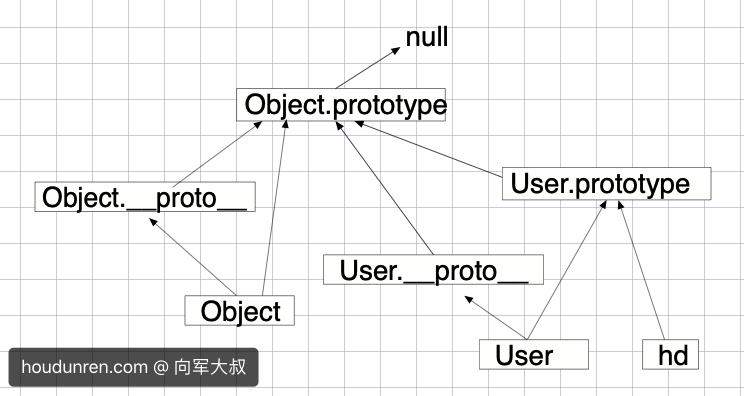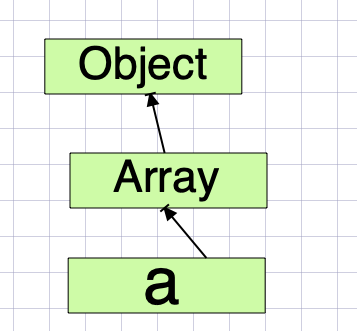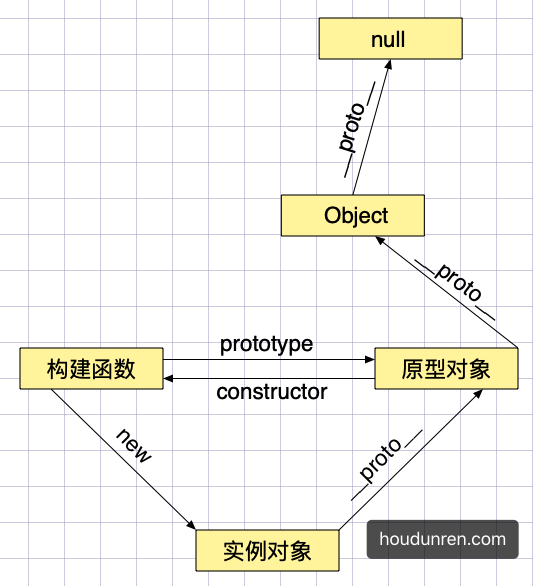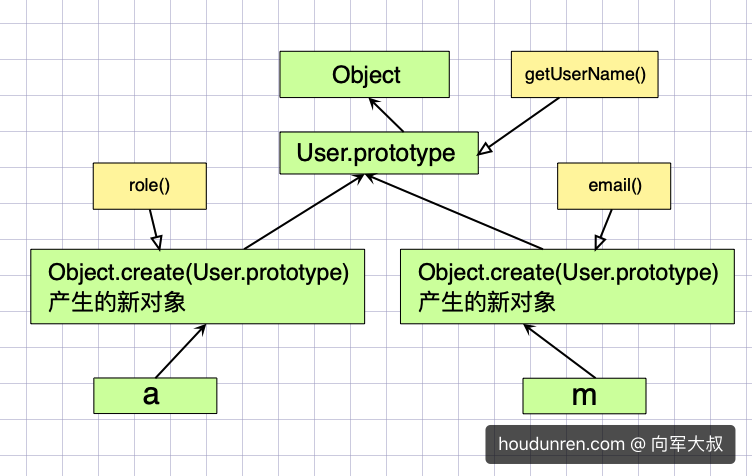Appearance
原型与继承
原型基础
原型对象
每个对象都有一个原型prototype对象,通过函数创建的对象也将拥有这个原型对象。原型是一个指向对象的指针。
- 可以将原型理解为对象的父亲,对象从原型对象继承来属性
- 原型就是对象除了是某个对象的父母外没有什么特别之处
- 所有函数的原型默认是
Object的实例,所以可以使用toString/toValues/isPrototypeOf等方法的原因 - 使用原型对象为多个对象共享属性或方法
- 如果对象本身不存在属性或方法将到原型上查找
- 使用原型可以解决,通过构建函数创建对象时复制多个函数造成的内存占用问题
- 原型包含
constructor属性,指向构造函数 - 对象包含
__proto__指向他的原型对象
下例使用的就是数组原型对象的 concat 方法完成的连接操作
let hd = ["a"];
console.log(hd.concat("b"));
console.log(hd);默认情况下创建的对象都有原型

let hd = { name: "后盾人" };
console.log(hd);以下 x、y 的原型都为元对象 Object,即 JS 中的根对象
let x = {};
let y = {};
console.log(Object.getPrototypeOf(x) == Object.getPrototypeOf(y)); //true我们也可以创建一个极简对象(纯数据字典对象)没有原型(原型为 null)

let hd = { name: 3 };
console.log(hd.hasOwnProperty("name"));
let xj = Object.create(null, {
name: {
value: "向军"
}
});
console.log(xj.hasOwnProperty("name")); //Error
//Object.keys是静态方法,不是原型方法所以是可以使用的
console.log(Object.keys(xj));函数拥有多个原型,prototype 用于实例对象使用,__proto__用于函数对象使用
function User() {}
User.__proto__.view = function() {
console.log("User function view method");
};
User.view();
User.prototype.show = function() {
console.log("后盾人");
};
let hd = new User();
hd.show();
console.log(User.prototype == hd.__proto__);下面是原型关系分析,与方法继承的示例

let hd = new Object();
hd.name = "后盾人";
Object.prototype.show = function() {
console.log("hodunren.com");
};
hd.show();
function User() {}
let xj = new User();
xj.show();
User.show();下面是使用构造函数创建对象的原型体现
- 构造函数拥有原型
- 创建对象时构造函数把原型赋予对象

function User() {}
let xj = new User();
console.log(xj.__proto__ == User.prototype);下面使用数组会产生多级继承即原型链

let hd = [];
console.log(hd);
console.log(hd.__proto__ == Array.prototype);
let str = "";
console.log(str.__proto__ == String.prototype);下面使用 setPrototypeOf 与 getPrototypeOf 获取与设置原型
let hd = {};
let parent = { name: "parent" };
Object.setPrototypeOf(hd, parent);
console.log(hd);
console.log(Object.getPrototypeOf(hd));使用自定义构造函数创建的对象的原型体现

function User() {}
let hd = new User();
console.log(hd);constructor 存在于 prototype 原型中,用于指向构建函数的引用。
function hd() {
this.show = function() {
return "show method";
};
}
const obj = new hd(); //true
console.log(obj instanceof hd);
const obj2 = new obj.constructor();
console.dir(obj2.show()); //show method使用对象的 constructor 创建对象
function User(name, age) {
this.name = name;
this.age = age;
}
function createByObject(obj, ...args) {
const constructor = Object.getPrototypeOf(obj).constructor;
return new constructor(...args);
}
let hd = new User("后盾人");
let xj = createByObject(hd, "向军", 12);
console.log(xj);原型链
通过引用类型的原型,继承另一个引用类型的属性与方法,这就是实现继承的步骤。

使用Object.setPrototypeOf 可设置对象的原型,下面的示例中继承关系为 obj>hd>cms。
Object.getPrototypeOf 用于获取一个对象的原型。
let obj = {
name: "后盾人"
};
let hd = {
web: "houdunren"
};
let cms = {
soft: "hdcms"
};
//让obj继承hd,即设置obj的原型为hd
Object.setPrototypeOf(obj, hd);
Object.setPrototypeOf(hd, cms);
console.log(obj.web);
console.log(Object.getPrototypeOf(hd) == cms); //true原型检测
instanceof 检测构造函数的 prototype 属性是否出现在某个实例对象的原型链上
function A() {}
function B() {}
function C() {}
const c = new C();
B.prototype = c;
const b = new B();
A.prototype = b;
const a = new A();
console.dir(a instanceof A); //true
console.dir(a instanceof B); //true
console.dir(a instanceof C); //true
console.dir(b instanceof C); //true
console.dir(c instanceof B); //false使用isPrototypeOf检测一个对象是否是另一个对象的原型链中
const a = {};
const b = {};
const c = {};
Object.setPrototypeOf(a, b);
Object.setPrototypeOf(b, c);
console.log(b.isPrototypeOf(a)); //true
console.log(c.isPrototypeOf(a)); //true
console.log(c.isPrototypeOf(b)); //true属性遍历
使用in 检测原型链上是否存在属性,使用 hasOwnProperty 只检测当前对象
let a = { url: "houdunren" };
let b = { name: "后盾人" };
Object.setPrototypeOf(a, b);
console.log("name" in a);
console.log(a.hasOwnProperty("name"));
console.log(a.hasOwnProperty("url"));使用 for/in 遍历时同时会遍历原型上的属性如下例
let hd = { name: "后盾人" };
let xj = Object.create(hd, {
url: {
value: "houdunren.com",
enumerable: true
}
});
for (const key in xj) {
console.log(key);
}hasOwnProperty 方法判断对象是否存在属性,而不会查找原型。所以如果只想遍历对象属性使用以下代码
let hd = { name: "后盾人" };
let xj = Object.create(hd, {
url: {
value: "houdunren.com",
enumerable: true
}
});
for (const key in xj) {
if (xj.hasOwnProperty(key)) {
console.log(key);
}
}借用原型
使用 call 或 apply 可以借用其他原型方法完成功能。
下面的 xj 对象不能使用max方法,但可以借用 hd 对象的原型方法
let hd = {
data: [1, 2, 3, 4, 5]
};
Object.setPrototypeOf(hd, {
max: function() {
return this.data.sort((a, b) => b - a)[0];
}
});
console.log(hd.max());
let xj = {
lessons: { js: 100, php: 78, node: 78, linux: 125 },
get data() {
return Object.values(this.lessons);
}
};
console.log(hd.__proto__.max.apply(xj));上例中如果方法可以传参,那就可以不在 xj 对象中定义 getter 方法了
let hd = {
data: [1, 2, 3, 4, 5]
};
Object.setPrototypeOf(hd, {
max: function(data) {
return data.sort((a, b) => b - a)[0];
}
});
console.log(hd.max(hd.data));
let xj = {
lessons: { js: 100, php: 78, node: 78, linux: 125 }
};
console.log(hd.__proto__.max.call(xj, Object.values(xj.lessons)));因为 Math.max 就是获取最大值的方法,所以代码可以再次优化
let hd = {
data: [1, 2, 3, 4, 5]
};
console.log(Math.max.apply(null, Object.values(hd.data)));
let xj = {
lessons: { js: 100, php: 78, node: 78, linux: 125 }
};
console.log(Math.max.apply(xj, Object.values(xj.lessons)));下面是获取设置了 class 属性的按钮,但 DOM 节点不能直接使用数组的filter 等方法,但借用数组的原型方法就可以操作了。
<body>
<button message="后盾人" class="red">后盾人</button>
<button message="hdcms">hdcms</button>
</body>
<script>
let btns = document.querySelectorAll("button");
btns = Array.prototype.filter.call(btns, item => {
return item.hasAttribute("class");
});
</script>this
this 不受原型继承影响,this 指向调用属性时使用的对象。
let hd = {
name: "后盾人"
};
let houdunren = {
name: "向军",
show() {
return this.name;
}
};
hd.__proto__ = houdunren;
console.log(hd.show()); //后盾人原型总结
prototype
函数也是对象也有原型,函数有 prototype 属性指向他的原型
为构造函数设置的原型指,当使用构造函数创建对象时把这个原型赋予给这个对象
function User(name) {
this.name = name;
}
User.prototype = {
show() {
return this.name;
}
};
let xj = new User("向军");
console.log(xj.show());函数默认prototype 指包含一个属性 constructor 的对象,constructor 指向当前构造函数
function User(name) {
this.name = name;
}
let xj = new User("向军");
console.log(xj);
console.log(User.prototype.constructor == User); //true
console.log(xj.__proto__ == User.prototype); //true
let lisi = new xj.constructor("李四");
console.log(lisi.__proto__ == xj.__proto__); //true原型中保存引用类型会造成对象共享属性,所以一般只会在原型中定义方法。
function User() {}
User.prototype = {
lessons: ["JS", "VUE"]
};
const lisi = new User();
const wangwu = new User();
lisi.lessons.push("CSS");
console.log(lisi.lessons); //["JS", "VUE", "CSS"]
console.log(wangwu.lessons); //["JS", "VUE", "CSS"]为 Object 原型对象添加方法,将影响所有函数
<body>
<button onclick="this.hide()">后盾人</button>
</body>
<script>
Object.prototype.hide = function() {
this.style.display = "none";
};
</script>了解了原型后可以为系统对象添加方法,比如为字符串添加了一截断函数。
- 不能将系统对象的原型直接赋值
String.prototype.truncate = function (len = 5) {
return this.length <= len ? this : this.substr(0, len) + '...';
}
console.log('后盾人每天不断视频教程'.truncate(3)); //后盾人...Object.create
使用Object.create创建一个新对象时使用现有对象做为新对象的原型对象

使用Object.create 设置对象原型
let user = {
show() {
return this.name;
}
};
let hd = Object.create(user);
hd.name = "向军";
console.log(hd.show());强以在设置时使用第二个参数设置新对象的属性
let user = {
show() {
return this.name;
}
};
let hd = Object.create(user, {
name: {
value: "后盾人"
}
});
console.log(hd);__proto__
在实例化对象上存在 __proto__ 记录了原型,所以可以通过对象访问到原型的属性或方法。
__proto__不是对象属性,理解为prototype的getter/setter实现,他是一个非标准定义__proto__内部使用getter/setter控制值,所以只允许对象或 null- 建议使用
Object.setPrototypeOf与Object.getProttoeypOf替代__proto__
下面修改对象的 __proto__ 是不会成功的,因为_proto__ 内部使用getter/setter 控制值,所以只允许对象或 null
let xj = {};
xj.__proto__ = "向军";
console.log(xj);下面定义的__proto__ 就会成功,因为这是一个极简对象,没有原型对象所以不会影响__proto__赋值。
let hd = Object.create(null);
hd.__proto__ = "向军";
console.log(hd); //{__proto__: "向军"}下面通过改变对象的 __proto__ 原型对象来实现继承,继承可以实现多层,

let hd = {
name: "后盾人"
};
let houdunren = {
show() {
return this.name;
}
};
let xj = {
handle() {
return `用户: ${this.name}`;
}
};
houdunren.__proto__ = xj;
hd.__proto__ = houdunren;
console.log(hd.show());
console.log(hd.handle());
console.log(hd);构造函数中的 __proto__ 使用
function User(name, age) {
this.name = name;
this.age = age;
}
User.prototype.show = function () {
return `姓名:${this.name},年龄:${this.age}`;
};
let lisi = new User('李四', 12);
let xiaoming = new User('小明', 32);
console.log(lisi.__proto__ == User.prototype); //true可以使用 __proto__ 或 Object.setPrototypeOf 设置对象的原型,使用Object.getProttoeypOf 获取对象原型。
function Person() {
this.getName = function() {
return this.name;
};
}
function User(name, age) {
this.name = name;
this.age = age;
}
let lisi = new User("李四", 12);
Object.setPrototypeOf(lisi, new Person());
console.log(lisi.getName()); //李四对象设置属性,只是修改对象属性并不会修改原型属性,使用hasOwnProperty 判断对象本身是否含有属性并不会检测原型。
function User() {}
const lisi = new User();
const wangwu = new User();
lisi.name = "小明";
console.log(lisi.name);
console.log(lisi.hasOwnProperty("name"));
//修改原型属性后
lisi.__proto__.name = "张三";
console.log(wangwu.name);
//删除对象属性后
delete lisi.name;
console.log(lisi.hasOwnProperty("name"));
console.log(lisi.name);使用 in 会检测原型与对象,而 hasOwnProperty 只检测对象,所以结合后可判断属性是否在原型中
function User() {
}
User.prototype.name = "后盾人";
const lisi = new User();
//in会在原型中检测
console.log("name" in lisi);
//hasOwnProperty 检测对象属性
console.log(lisi.hasOwnProperty("name"));使用建议
通过前介绍我们知道可以使用多种方式设置原型,下面是按时间顺序的排列
prototype构造函数的原型属性Object.create创建对象时指定原型__proto__声明自定义的非标准属性设置原型,解决之前通过Object.create定义原型,而没提供获取方法Object.setPrototypeOf设置对象原型
这几种方式都可以管理原型,一般以我个人情况来讲使用 prototype 更改构造函数原型,使用 Object.setPrototypeOf 与 Object.getPrototypeOf 获取或设置原型。
构造函数
原型属性
构造函数在被new 时把构造函数的原型(prototype)赋值给新对象。如果对象中存在属性将使用对象属性,不再原型上查找方法。
- 构造函数只会产生一个原型对象
function hd() {
this.show = function() {
return "show in object";
};
}
hd.prototype.show = function() {
return "show in prototype";
};
const obj = new hd();
console.log(obj.show());对象的原型引用构造函数的原型对象,是在创建对象时确定的,当构造函数原型对象改变时会影响后面的实例对象。
function hd() {}
hd.prototype.name = "hdcms";
const obj1 = new hd();
console.log(obj1.name); //hdcms
hd.prototype = {
name: "后盾人"
};
const obj2 = new hd();
console.dir(obj2.name); //后盾人constructor
构造函数的原型中包含属性 constructor 指向该构造函数,以下代码说明了这一点
function User(name) {
this.name = name;
}
let hd = new User("后盾人");
let xj = new hd.constructor("向军");
console.log(xj);以下代码直接设置了构造函数的原型将造成 constructor 丢失
function User(name) {
this.name = name;
}
User.prototype = {
show: function() {}
};
let hd = new User("后盾人");
let xj = new hd.constructor("向军");
console.log(xj); //String {"向军"}正确的做法是要保证原型中的 constructor指向构造函数
function User(name) {
this.name = name;
}
User.prototype = {
constructor: User,
show: function() {}
};
let hd = new User("后盾人");
let xj = new hd.constructor("向军");
console.log(xj);使用优化
使用构造函数会产生函数复制造成内存占用,及函数不能共享的问题。
function User(name) {
this.name = name;
this.get = function() {
return this.name;
};
}
let lisi = new User("小明");
let wangwu = new User("王五");
console.log(lisi.get == wangwu.get); //false体验通过原型定义方法不会产生函数复制
function User(name) {
this.name = name;
}
User.prototype.get = function() {
return "后盾人" + this.name;
};
let lisi = new User("小明");
let wangwu = new User("王五");
console.log(lisi.get == wangwu.get); //true
//通过修改原型方法会影响所有对象调用,因为方法是共用的
lisi.__proto__.get = function() {
return "后盾人" + this.name;
};
console.log(lisi.get());
console.log(wangwu.get());下面演示使用原型为多个实例共享属性
function User(name, age) {
this.name = name;
this.age = age;
this.show = () => {
return `你在${this.site}的姓名:${this.name},年龄:${this.age}`;
}
}
User.prototype.site = '后盾人';
let lisi = new User('李四', 12);
let xiaoming = new User('小明', 32);
console.log(lisi.show()); //你在后盾人的姓名:李四,年龄:12
console.log(xiaoming.show()); //你在后盾人的姓名:小明,年龄:32将方法定义在原型上为对象共享,解决通过构造函数创建对象函数复制的内存占用问题
function User(name) {
this.name = name;
}
User.prototype.get = function () {
return '后盾人' + this.name;
}
let lisi = new User('小明');
let wangwu = new User('王五');
console.log(lisi.get == wangwu.get); //true
//通过修改原型方法会影响所有对象调用,因为方法是共用的
lisi.__proto__.get = function () {
return '后盾人' + this.name;
}
console.log(lisi.get());
console.log(lisi.get());
console.log(wangwu.get());使用Object.assign一次设置原型方法来复用,后面会使用这个功能实现 Mixin 模式
function User(name, age) {
this.name = name;
this.age = age;
}
Object.assign(User.prototype, {
getName() {
return this.name;
},
getAge() {
return this.age;
}
});
let lisi = new User('李四', 12);
let xiaoming = new User('小明', 32);
console.log(lisi.getName()); //李四
console.log(lisi.__proto__)体验继承
下面为 Stu 更改了原型为User 的实例对象,lisi是通过构造函数Stu创建的实例对象
lisi在执行getName方法时会从自身并向上查找原型,这就是原型链特性- 当然如果把
getName添加到对象上,就不继续追溯原型链了
"use strict";
function User() {}
User.prototype.getName = function() {
return this.name;
};
function Stu(name) {
this.name = name;
}
Stu.prototype = new User();
const lisi = new Stu("李四");
console.log(lisi.__proto__);
console.log(lisi.getName());继承与多态
当对象中没使用的属性时,JS 会从原型上获取这就是继承在 JavaScript 中的实现。
继承实现
下面使用Object.create 创建对象,做为Admin、Member的原型对象来实现继承。

function User() {}
User.prototype.getUserName = function() {};
function Admin() {}
Admin.prototype = Object.create(User.prototype);
Admin.prototype.role = function() {};
function Member() {}
Member.prototype = Object.create(User.prototype);
Member.prototype.email = function() {};
console.log(new Admin());
console.log(new Member());不能使用以下方式操作,因为这样会改变 User 的原型方法,这不是继承,这是改变原型
...
function User() {}
User.prototype.getUserName = function() {};
function Admin() {}
Admin.prototype = User.prototype;
Admin.prototype.role = function() {};
...构造函数
有多种方式通过构造函数创建对象
function Admin() {}
console.log(Admin == Admin.prototype.constructor); //true
let hd = new Admin.prototype.constructor();
console.log(hd);
let xj = new Admin();
console.log(xj);因为有时根据得到的对象获取构造函数,然后再创建新对象所以需要保证构造函数存在,但如果直接设置了 Admin.prototype 属性会造成constructor丢失,所以需要再次设置constructor值。
function User() {}
function Admin() {}
Admin.prototype = Object.create(User.prototype);
Admin.prototype.role = function() {};
let xj = new Admin();
console.log(xj.constructor); //constructor丢失,返回User构造函数
Admin.prototype.constructor = Admin;
let hd = new Admin();
console.log(hd.constructor); //正确返回Admin构造函数
//现在可以通过对象获取构造函数来创建新对象了
console.log(new hd.constructor());使用Object.defineProperty定义来禁止遍历 constructor 属性
function User() {}
function Admin(name) {
this.name = name;
}
Admin.prototype = Object.create(User.prototype);
Object.defineProperty(Admin.prototype, "constructor", {
value: Admin,
enumerable: false //禁止遍历
});
let hd = new Admin("后盾人");
for (const key in hd) {
console.log(key);
}完全重写构建函数原型,只对后面应用对象有效
function User() {}
const lisi = new User();
User.prototype = {
show() {
return "prototype show";
}
};
const wangwu = new User();
console.log(wangwu.show());
console.log(lisi.show()); // lisi.show is not a function方法重写
下而展示的是子类需要重写父类方法的技巧。
function Person() {}
Person.prototype.getName = function() {
console.log("parent method");
};
function User(name) {}
User.prototype = Object.create(Person.prototype);
User.prototype.constructor = User;
User.prototype.getName = function() {
//调用父级同名方法
Person.prototype.getName.call(this);
console.log("child method");
};
let hd = new User();
hd.getName();多态
根据多种不同的形态产生不同的结果,下而会根据不同形态的对象得到了不同的结果。
function User() {}
User.prototype.show = function() {
console.log(this.description());
};
function Admin() {}
Admin.prototype = Object.create(User.prototype);
Admin.prototype.description = function() {
return "管理员在此";
};
function Member() {}
Member.prototype = Object.create(User.prototype);
Member.prototype.description = function() {
return "我是会员";
};
function Enterprise() {}
Enterprise.prototype = Object.create(User.prototype);
Enterprise.prototype.description = function() {
return "企业帐户";
};
for (const obj of [new Admin(), new Member(), new Enterprise()]) {
obj.show();
}深挖继承
继承是为了复用代码,继承的本质是将原型指向到另一个对象。
构造函数
我们希望调用父类构造函数完成对象的属性初始化,但像下面这样使用是不会成功的。因为此时 this 指向了 window,无法为当前对象声明属性。
function User(name) {
this.name = name;
console.log(this);// Window
}
User.prototype.getUserName = function() {
return this.name;
};
function Admin(name) {
User(name);
}
Admin.prototype = Object.create(User.prototype);
Admin.prototype.role = function() {};
let xj = new Admin("向军大叔");
console.log(xj.getUserName()); //undefined解决上面的问题是使用 call/apply 为每个生成的对象设置属性
function User(name) {
this.name = name;
console.log(this); // Admin
}
User.prototype.getUserName = function() {
return this.name;
};
function Admin(name) {
User.call(this, name);
}
Admin.prototype = Object.create(User.prototype);
let xj = new Admin("向军大叔");
console.log(xj.getUserName()); //向军大叔原型工厂
原型工厂是将继承的过程封装,使用继承业务简单化。
function extend(sub, sup) {
sub.prototype = Object.create(sup.prototype);
sub.prototype.constructor = sub;
}
function Access() {}
function User() {}
function Admin() {}
function Member() {}
extend(User, Access); //User继承Access
extend(Admin, User); //Admin继承User
extend(Member, Access); //Member继承Access
Access.prototype.rules = function() {};
User.prototype.getName = function() {};
console.log(new Admin()); // 继承关系: Admin>User>Access>Object
console.log(new Member()); //继承关系:Member>Access>Object对象工厂
在原型继承基础上,将对象的生成使用函数完成,并在函数内部为对象添加属性或方法。
function User(name, age) {
this.name = name;
this.age = age;
}
User.prototype.show = function() {
console.log(this.name, this.age);
};
function Admin(name, age) {
let instance = Object.create(User.prototype);
User.call(instance, name, age);
instance.role=function(){
console.log('admin.role');
}
return instance;
}
let hd = Admin("后盾人", 19);
hd.show();
function member(name, age) {
let instance = Object.create(User.prototype);
User.call(instance, name, age);
return instance;
}
let lisi = member("李四", 28);
lisi.show();Mixin 模式
JS不能实现多继承,如果要使用多个类的方法时可以使用mixin混合模式来完成。
mixin类是一个包含许多供其它类使用的方法的类mixin类不用来继承做为其它类的父类
其他语言也有类似的操作比如
php语言中可以使用trait完成类似操作。
下面是示例中 Admin需要使用 Request.prototype 与 Credit 的功能,因为JS 是单继承,我们不得不将无关的类连接在一下,显然下面的代码实现并不佳
function extend(sub, sup) {
sub.prototype = Object.create(sup.prototype);
sub.prototype.constructor = sub;
}
function Credit() {}
function Request() {}
function User(name, age) {
this.name = name;
this.age = age;
}
extend(Request, Credit);
extend(User, Request);
Credit.prototype.total = function() {
console.log("统计积分");
};
Request.prototype.ajax = function() {
console.log("请求后台");
};
User.prototype.show = function() {
console.log(this.name, this.age);
};
function Admin(...args) {
User.apply(this, args);
}
extend(Admin, User);
let hd = new Admin("向军", 19);
hd.show();
hd.total(); //统计积分
hd.ajax(); //请求后台下面分拆功能使用 Mixin 实现多继承,使用代码结构更清晰。只让 Admin 继承 User 原型
function extend(sub, sup) {
sub.prototype = Object.create(sup.prototype);
sub.prototype.constructor = sub;
}
function User(name, age) {
this.name = name;
this.age = age;
}
User.prototype.show = function() {
console.log(this.name, this.age);
};
const Credit = {
total() {
console.log("统计积分");
}
};
const Request = {
ajax() {
console.log("请求后台");
}
};
function Admin(...args) {
User.apply(this, args);
}
extend(Admin, User);
Object.assign(Admin.prototype, Request, Credit);
let hd = new Admin("向军", 19);
hd.show();
hd.total(); //统计积分
hd.ajax(); //请求后台mixin 类也可以继承其他类,比如下面的 Create 类获取积分要请求后台,就需要继承 Request 来完成。
super是在mixin类的原型中查找,而不是在User原型中
function extend(sub, sup) {
sub.prototype = Object.create(sup.prototype);
sub.prototype.constructor = sub;
}
function User(name, age) {
this.name = name;
this.age = age;
}
User.prototype.show = function() {
console.log(this.name, this.age);
};
const Request = {
ajax() {
return "请求后台";
}
};
const Credit = {
__proto__: Request,
total() {
console.log(super.ajax() + ",统计积分");
}
};
function Admin(...args) {
User.apply(this, args);
}
extend(Admin, User);
Object.assign(Admin.prototype, Request, Credit);
let hd = new Admin("向军", 19);
hd.show();
hd.total(); //统计积分
hd.ajax(); //请求后台实例操作
使用 call/apply 制作选项卡

<style>
* {
padding: 0;
margin: 0;
}
body {
display: flex;
justify-content: center;
align-items: center;
width: 100vw;
height: 100vh;
}
main {
width: 400px;
flex-direction: column;
position: relative;
margin-right: 20px;
}
main nav {
display: flex;
height: 50px;
align-items: center;
}
main nav a {
background: #95a5a6;
margin-right: px;
padding: 10px 20px;
border: solid 1px #333;
color: #fff;
text-decoration: none;
}
main nav a:first-of-type {
background: #e67e22;
}
section {
height: 200px;
width: 100%;
background: #f1c40f;
position: absolute;
font-size: 5em;
display: none;
}
.hd-tab section:first-of-type {
display: block;
}
section:nth-child(even) {
background: #27ae60;
}
</style>
<body>
<main class="tab1">
<nav>
<a href="javascript:;">后盾人</a>
<a href="javascript:;">hdcms</a>
</nav>
<section>1</section>
<section>2</section>
</main>
<main class="tab2">
<nav>
<a href="javascript:;">后盾人</a>
<a href="javascript:;">hdcms</a>
</nav>
<section>1</section>
<section>2</section>
</main>
</body>
<script>
//继承工厂
function extend(sub, sup) {
sub.prototype = Object.create(sup.prototype);
sub.prototype.constructor = sub;
}
//动作类
function Animation() {}
Animation.prototype.show = function() {
this.style.display = "block";
};
//隐藏所有元素
Animation.prototype.hide = function() {
this.style.display = "none";
};
//必变元素集合背景
Animation.prototype.background = function(color) {
this.style.background = color;
};
//选项卡类
function Tab(tab) {
this.tab = tab;
this.links = null;
this.sections = null;
}
extend(Tab, Animation);
Tab.prototype.run = function() {
this.links = this.tab.querySelectorAll("a");
this.sections = this.tab.querySelectorAll("section");
this.bindEvent();
this.action(0);
};
//绑定事件
Tab.prototype.bindEvent = function() {
this.links.forEach((el, i) => {
el.addEventListener("click", () => {
this.reset();
this.action(i);
});
});
};
//点击后触发动作
Tab.prototype.action = function(i) {
this.background.call(this.links[i], "#e67e22");
this.show.call(this.sections[i]);
};
//重置link与section
Tab.prototype.reset = function() {
this.links.forEach((el, i) => {
this.background.call(el, "#95a5a6");
this.hide.call(this.sections[i]);
});
};
new Tab(document.querySelector(".tab1")).run();
new Tab(document.querySelector(".tab2")).run();
</script>